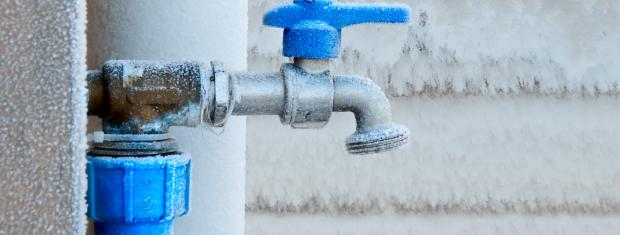
3 Major Threats Homeowners Face During Severe Cold
1. Frozen Pipes
Once a water line falls below 32 degrees, it will start to freeze. When this happens, the ice creates an increase in pressure; once the pressure gets too high, it bursts.
Prevention
- Once temperatures start to get very low, it’s beneficial to keep the water line moving. Allow cold water to drip from the faucet served by exposed pipes, you could even let the faucet trickle. Running water through the pipe helps prevent them from freezing.
- Keep garage doors closed if there are water supply lines in the garage.
- Open your bathroom and kitchen cabinet doors to circulate warmer air from your home around the plumbing.
- Maintain a consistent temperature throughout the day and night. By temporarily suspending the use of lower nighttime temperatures in your home - you may incur a higher heating bill, but this will help to prevent your pipes from bursting by providing them with a steady exposure of warmth.
- Check all pipes in your home a few times a day to make sure they are running properly. If one pipe freezes, others may freeze, too.
- If you will be traveling away during cold temperatures, leave the heat on in your home and set the thermostat no lower than 55° F.
Signs of Frozen Pipes
A tell-tale sign you might have a frozen pipe is turning your faucet on and only receiving a trickle of water. If you suspect that you might have a frozen pipe, there are a few things you can do to thaw them to prevent further damage:
- Keep the faucet open. Running water will begin to melt frozen areas of the line and prevent the ice from completely closing off the pipe.
- Try to apply some sort of heat around the section of the pipe that is frozen. You could wrap an electronic heating pad around the pipe or wrap pipes with towels soaked in hot water. NEVER use an open flame device such as a blowtorch, propane heater or charcoal stove.
- If you cannot locate the frozen area, if it is inaccessible, or if you cannot thaw the pipe, call a licensed plumber before things get out of hand.
2. Sump Pump Failure
Your sump pump is responsible for eliminating moisture from your basement and preventing different kinds of water damage. It’s extremely important to keep your sump pump in working order during the winter months to ensure that if you do experience something such as a frozen and burst pipe, the water damage can be kept to a minimal.
Testing Your Sump Pump
Sump Pumps with Two Cords
- Locate the two electrical cords of the sump pump, the pump cord and the float cord.
- Unplug both cords from the pump, keeping the pump cord plugged into the outlet.
- Turn on the pump.
- Listen for a humming sound.
If you hear a humming sound when you turn the pump on, it’s working. You can reconnect the two cords as they were. Plug the float cord in first, then the pump cord in the back of the float cord.
Single-Corded Pumps
- Pour approximately 20 liters of water into the pump until the float rises. The pump should kick on.
- While the pump is running, water should be pumping out.
- The pump should turn itself off when it has removed all of the water.
Sump Pump Failure Prevention
- Locate the exit pipe outside and make sure it isn’t clogged with any sort of debris. If there is debris, make sure it is removed entirely.
- Reduce the sump pumps workload by redirecting water away from your foundation and basement. In winter months, this means doing your best to keep significant amounts of snow from melting alongside your home. When a large amount of water needs dispersed at once, your sump pump could overheat and potentially fail.
- Insulate the intake and discharge line to prevent them from freezing. Burying the discharge hose in the ground can help prevent them from freezing. The portion of the hose that lies above ground should be insulated as well. If it isn’t, try wrapping it with insulation tape or electrical cable.
- Maintain a temperature of 55 degrees Fahrenheit in your home. The basement can be an inherently cold space, so keep a close eye on the temperature here. If necessary, utilize a space heater following the safety guidelines to help maintain a consistent temperature.
- Use a larger discharge hose to allow more room for water to pass through. A smaller hose is more likely to freeze and have an ice blockage preventing water from leaving through the sump pump.
3. Ice Dams
What is an Ice Dam
An ice dam is a ridge of ice that forms on your roofline preventing water from melting snow from draining correctly off the roof. With nowhere to go, this water can then back up below roof shingles and make its way into your home causing extensive damage.
Signs of Ice Dams
Keep an eye out for icicles around the exterior of your home as they can be a precursor to ice dams. Whenever possible, and only when safe to do so, remove icicles from your roofline (don’t stand directly beneath them, though!). If the icicles are too high for you to reach from the ground, consider hiring a contractor to assist in their removal.
Water stains or moisture in your attic or along the ceiling of exterior walls of your home is also a sign that water has penetrated the roof membrane of your home.
Removing Ice Dams
Removing the ice dam from your roof as quickly as possible is essential to preventing severe damage within your home. There are a few different approaches to removing an ice dam, but one of the safest routes is to use a calcium chloride ice melt. This deicer can be found at hardware and home improvement stores, they usually come in tablet or crystal form. Following the label instructions, sprinkle or distribute the substance along the top of the ice in your gutter. It will slowly melt the ice, and the substances will drain out of your gutters with the water.
You can try your best to chip away at the ice and remove sections of it but only if it is safe to reach, using a ladder in snowy/icy conditions can be very dangerous. If the ice dam is out of reach and begins to grow, it’s probably best to call a contractor to remove it appropriately.
Extreme cold can put our homes under extreme pressure and it has the potential to cause extensive damage. Keeping an eye on your pipes, sump pump and roofline is best practice to ensure nothing looks out of the ordinary during extreme temperatures.


